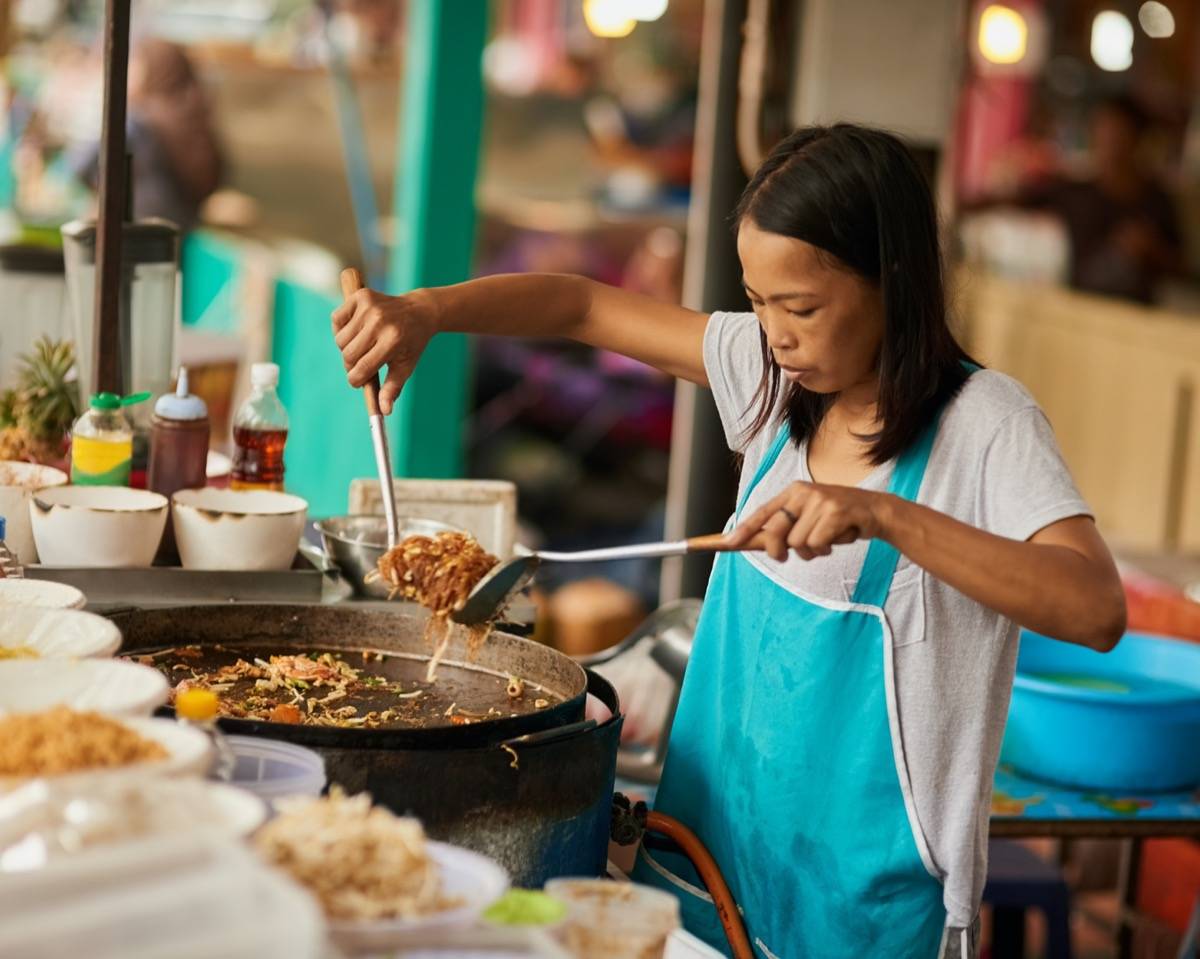Explore the rich world of Thai food, where every dish has a story and flavors come together in perfect harmony.
The Essence of Thai Cuisine
Thai food is not merely a culinary experience; it embodies the country’s culture, history, and traditions. The distinctive flavors and vibrant array of ingredients found in Thai dishes reflect the rich tapestry of Thailand’s geography and social fabric. You will discover that the essence of Thai cuisine is deeply rooted in its use of fresh herbs, spices, rice, and vegetables, combined in ways that both excite and nourish.
Geographic Influences
Thailand’s diverse landscapes play a significant role in shaping its culinary offerings. The northern regions offer ingredients like herbs and spices, while the south is known for its seafood. The central plains, known as the rice bowl of Thailand, are the heart of the country’s food culture. The geographic diversity leads to an equally diverse array of cooking techniques, from grilling to steaming.
| Region | Key Ingredients | Popular Dishes |
|---|---|---|
| Northern | Rice, vegetables, herbs | Khao Soi, Sai Oua |
| Northeastern | Sticky rice, grilled meats | Som Tum, Larb |
| Central | Rice, fish, fresh herbs | Pad Thai, Green Curry |
| Southern | Seafood, coconut milk | Massaman Curry, Curry with Crab |
Historical Context
The origins of Thai cuisine trace back centuries, influenced by neighboring countries and trade routes. Chinese, Indian, and Malay culinary practices have all intermingled with indigenous Thai cooking, resulting in a unique gastronomic identity. The introduction of ingredients such as chilies from the Americas dramatically altered Thai cooking, paving the way for the bold flavors we recognize today.
Fundamental Ingredients in Thai Cooking
Understanding the key ingredients that define Thai food is crucial. A harmonious balance of flavors—spicy, sour, sweet, salty, and bitter—delivers a taste experience that is distinctly Thai.
Rice: The Staple Food
Rice is the cornerstone of Thai meals. Jasmine rice, known for its fragrant aroma and delicate texture, is the most popular choice. Rice not only sustains but shapes social interactions and rituals throughout the country.
Fresh Herbs and Spices
Fresh herbs and spices infuse Thai dishes with their characteristic flavors. Key ingredients include:
- Thai basil: A aromatic herb with a sweet, peppery flavor.
- Lemongrass: A citrusy herb used to add brightness to soups and curries.
- Galangal: Similar to ginger, but more aromatic and citrusy, it serves as a fundamental base in many curries.
- Kaffir lime leaves: Used for their fragrant aroma, essential for many soups and curries.
Fish Sauce and Shrimp Paste
Fish sauce (nam pla) and shrimp paste (kapi) are indispensable in Thai cuisine. They provide umami, deepening the overall flavor profile of dishes. You may find these ingredients in many sauces and marinades, exemplifying the salty aspect of Thai cooking.
Coconut Milk
Coconut milk is a crucial component in many Thai curries and soups, adding a rich and creamy texture. It balances the heat of chilies and enhances the sweetness of other ingredients.
The Harmony of Flavors
In Thai cuisine, the interplay of flavors is guided by a principle of balance. The classic Thai palate seeks a perfect harmony among five primary tastes: sweet, sour, salty, spicy, and bitter. This balance can be seen in many traditional dishes.
Sweetness
Sweetness often arises from ingredients like sugar, fruits, or sweetened sauces. For instance, when making Pad Thai, the addition of palm sugar creates a delicate sweetness that complements the dish’s salty components.
Sourness
Sour flavors usually come from lime juice, tamarind, or vinegar, lending brightness to a dish. The hallmark of a classic Thai salad, such as Som Tum (papaya salad), is its vibrant sourness balanced with sweetness and spiciness.
Saltiness
Saltiness is predominantly introduced through fish sauce, which acts as a seasoning. It’s essential to remember that a little goes a long way, and finding the right amount is key to achieving a balanced dish.
Spiciness
Chilies are often used liberally in Thai cuisine. From fresh bird’s eye chilies to chili flakes, the degree of heat can be adjusted according to personal preference. While spice can overwhelm other flavors, when balanced properly, it enhances the entire dish.
Bitterness
Bitterness can be found in herbs and certain vegetables. Though often underrepresented in other cuisines, the bitterness in Thai dishes serves to counterbalance sweetness, helping to create a harmonious overall flavor profile.
Traditional Thai Dishes
Familiarizing yourself with iconic Thai dishes is essential for appreciating the culinary landscape. Each dish tells a story, reflecting the history and cultural ethos of Thailand.
Tom Yum Goong
Tom Yum Goong is a hot and sour soup that features shrimp, mushrooms, and a fragrant broth made with lemongrass, kaffir lime leaves, and galangal. It encapsulates the quintessential balance of Thai flavors—spicy, sour, and savory—all in one bowl.
Pad Thai
Often regarded as Thailand’s national dish, Pad Thai is a stir-fried noodle dish that combines rice noodles, shrimp or chicken, bean sprouts, and a rich tamarind sauce, topped with crushed peanuts and lime. Each ingredient contributes to an engaging interplay of flavors and textures.
Green Curry
Green curry (Gang Kiew Wan) is renowned for its vibrant green color, achieved through the use of green chilies and Thai basil. It features tender meat or tofu simmered in a rich coconut milk-based sauce and is often served with jasmine rice, providing a creamy counterpoint to the spicy curry.
Som Tum
Som Tum, or green papaya salad, showcases the crispness of unripe papaya, combined with fresh vegetables and dressed with a tangy, spicy sauce. The salad exemplifies the fresh and vibrant qualities of Thai food and reflects the country’s fondness for salads that are as delicious as they are colorful.
| Dish | Main Ingredients | Flavor Profile |
|---|---|---|
| Tom Yum Goong | Shrimp, mushrooms, lemongrass | Spicy, sour, savory |
| Pad Thai | Rice noodles, shrimp, tamarind | Sweet, savory, slight acidity |
| Green Curry | Green chilies, meat/tofu, coconut milk | Spicy, creamy, sweet |
| Som Tum | Green papaya, tomatoes, chilies | Fresh, crispy, spicy, sour |
Street Food Culture
One cannot discuss Thai cuisine without mentioning the vibrant street food scene. You will find food stalls and vendors in bustling markets and along city streets, offering an array of quick, affordable, and delicious meals. Street food encapsulates the heart of Thai food culture, and sampling it is an integral part of the experience.
The Atmosphere of Street Markets
The energy of Thai street food markets is palpable, with tantalizing aromas wafting through the air as vendors prepare dishes right before your eyes. You will witness a community event as friends and families gather around tables, sharing food and conversation in a lively, social environment.
Popular Street Foods
Some of the most beloved street food items include:
- Pad Krapow: Stir-fried basil with meat (often chicken or pork) and served over rice, topped with a fried egg.
- Satay: Grilled skewers of marinated meat served with a rich peanut sauce.
- Mango Sticky Rice: A sweet dessert made with glutinous rice, fresh mango, and coconut milk.
The Role of Street Food in Thai Culture
Street food is more than just a meal; it showcases local ingredients and traditional recipes passed down through generations. Each vendor often specializes in one or two dishes, emphasizing craftsmanship and dedication toward their craft. Street food also plays a vital role in fostering community, providing an opportunity for social interactions and shared experiences.
Culinary Techniques
Thai cooking employs a variety of techniques that are vital in achieving the complex flavors characteristic of its dishes.
Stir-Frying
Stir-frying is a predominant cooking method, allowing for quick preparation while retaining the fresh flavors and textures of ingredients. Using a wok over high heat facilitates this technique, enabling even cooking and minimizing nutrient loss.
Steaming
Steaming is a healthy cooking method employed for various dishes, from fish to dumplings. It preserves nutrients and enhances the natural flavors of the ingredients.
Grilling
Grilling, often used for marinating and cooking meats, adds a smoky flavor that further enriches the overall taste. Street vendors often grill skewers of marinated meat over charcoal, creating an aromatic experience.
Braising
Braising is often employed in curries, where meat is slow-cooked in coconut milk and spices, allowing flavors to meld together beautifully. The result is tender, richly flavored dishes that exemplify the heartiness of Thai cooking.
The Role of Presentation
In Thailand, food is an art form, and the aesthetic presentation of dishes is paramount. A beautifully arranged plate is considered just as important as the taste. You will often see vibrant colors from fresh herbs, vegetables, and garnishes, all contributing to a feast for both the eyes and the palate.
Garnishes and Accompaniments
Common garnishes include lime wedges, fresh herbs, and sliced vegetables, enhancing the visual appeal while also providing additional flavors. This attention to detail reflects the cultural significance of food in Thailand, where meals are seen as social events and celebrations.
Plate Arrangement
Arranging food on a plate is an integral part of Thai dining. Traditional dishes are often served on communal platters, encouraging sharing and interaction among diners. This style of serving fosters a sense of connection and community at the dining table.
Modern Influences and Innovations
While traditional Thai cuisine remains deeply respected, modernization has led to innovative approaches that combine classical techniques with contemporary influences.
Fusion Cuisine
The globalization of culinary trends has given rise to fusion dishes that blend Thai flavors with international cuisines. You may encounter Thai-inspired sushi, pasta, or even tacos, each infusing familiar dishes with spicy, vibrant Thai elements.
Health-Conscious Eating
With the increasing emphasis on health and well-being, many Thai chefs have embraced healthier cooking methods and ingredients. The use of organic produce, gluten-free alternatives, and plant-based options is on the rise, allowing for traditional Thai flavors to be enjoyed within modern dietary preferences.
Culinary Tourism
Culinary tourism has gained popularity, with travelers engaging in cooking classes and food tours that allow them to learn about and connect with Thai food culture. You may find that these experiences deepen your appreciation for the complexity and nuance of traditional Thai cuisine.
Conclusion
Understanding Thai food culture goes beyond the flavors and techniques; it encompasses the community, history, and philosophy surrounding it. The next time you savor a bowl of Tom Yum Goong or a plate of Pad Thai, remember that you are partaking in a rich cultural tradition that spans centuries. You may find a new appreciation for not just the food itself but the intricate web of influences that have shaped what we recognize today as Thai cuisine. Your culinary journey through Thailand is not merely about nourishment; it is an exploration of stories, memories, and a way of life, all woven beautifully into each bite.


